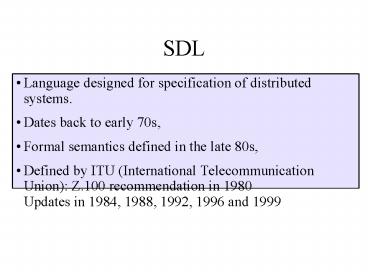SDL - PowerPoint PPT Presentation
1 / 16
Title:
SDL
Description:
... StateCharts, it is based on the CFSM model of computation; each FSM is called a process, ... processes and blocks becoming replaced by agents. Tools for ... – PowerPoint PPT presentation
Number of Views:87
Avg rating:3.0/5.0
Title: SDL
1
SDL
- Language designed for specification of
distributed systems. - Dates back to early 70s,
- Formal semantics defined in the late 80s,
- Defined by ITU (International Telecommunication
Union) Z.100 recommendation in 1980Updates in
1984, 1988, 1992, 1996 and 1999
2
SDL
- Provides textual and graphical formats to please
all users, - Just like StateCharts, it is based on the CFSM
model of computation each FSM is called a
process, - However, it uses message passing instead of
shared memory for communications, - SDL supports operations on data.
3
SDL-representation of FSMs/processes
state
input
output
4
Operations on data
- Variables can be declared locally for processes.
- Their type can be predefined or defined in SDL
itself. - SDL supports abstract data types (ADTs). Examples
5
Communication among SDL-FSMs
- Communication between FSMs (or processes) is
based on message-passing, assuming a potentially
indefinitely large FIFO-queue.
- Each process fetches next entry from FIFO,
- checks if input enables transition,
- if yes transition takes place,
- if no input is ignored (exception
SAVE-mechanism).
6
Process interaction diagrams
- Interaction between processes can be described in
process interaction diagrams (special case of
block diagrams). - In addition to processes, these diagrams contain
channels and declarations of local signals. - Example
,
7
Designation of recipients
- Through process identifiersExample OFFSPRING
represents identifiers of processes generated
dynamically. - ExplicitlyBy including the channel name.
- ImplicitlyIf signal names imply channel names
(B ? Sw1)
8
Hierarchy in SDL
- Process interaction diagrams can be included in
blocks. The root block is called system.
Processes cannot contain other processes, unlike
in StateCharts.
9
Timers
- Timers can be declared locally. Elapsed timers
put signal into queue (not necessarily processed
immediately). - RESET also removes timer signal from queue.
10
Additional language elements
- SDL includes a number of additional language
elements, like - procedures
- creation and termination of processes
- advanced description of data
11
Application description of network protocols
12
Larger example vending machine
Machine selling pretzels, (potato) chips,
cookies, and doughnuts accepts nickels, dime,
quarters, and half-dollar coins. Not a
distributed application.
J.M. Bergé, O. Levia, J. Roullard High-Level
System Modeling, Kluwer Academic Publishers, 1995
13
Overall view of vending machine
14
DecodeRequests
15
ChipHandler
16
Versions and tools
- SDL-88
- SDL-92 object orientation added
- SDL-96
- SDL-2000 Extended graphical supportprocesses
and blocks becoming replaced by agents. - Tools for connecting to MSCs
- Tools for connecting to UML
- Tools for translation to CHILL.
- Information www.sdl-forum.org
17
Evaluation
- Excellent for distributed applications(was used
to specify ISDN), - Commercial tools available from SINTEF,
Telelogic, Cinderella (//www.cinderella.dk). - Not necessarily deterministic(order, in which
FSMs are reading input is unknown)? no
synchronous language, - Implementation requires bound for the maximum
length of FIFOs may be very difficult to
compute, - Timer concept adequate just for soft deadlines,
- Limited way of using hierarchies,
- Limited programming language support,
- No description of non-functional properties.
18
Summary
- General language properties
- Synchronous vs. asynchronous languages
- Properties of processes
- Communication
- Timing
- Access to special I/O devices
- SDL
- Representation of processes
- Communication block diagrams
- Timers and other language elements
- Example Vending machine
- Versions and evaluation































